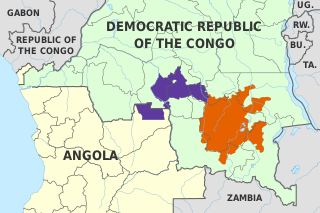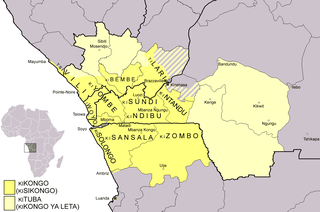Related Research Articles

The Bantu languages are a language family of about 600 languages that are spoken by the Bantu peoples of Central, Southern, Eastern and Southeast Africa. They form the largest branch of the Southern Bantoid languages.

Luba-Kasai, also known as Cilubà or Tshilubà, Luba-Lulua, is a Bantu language of Central Africa and a national language of the Democratic Republic of the Congo, alongside Lingala, Swahili, and Kikongo ya leta.

Kongo or Kikongo is one of the Bantu languages spoken by the Kongo people living in the Democratic Republic of the Congo, the Republic of the Congo, Gabon and Angola. It is a tonal language. It was spoken by many of those who were taken from the region and sold as slaves in the Americas. For this reason, while Kongo still is spoken in the above-mentioned countries, creolized forms of the language are found in ritual speech of Afro-American religions, especially in Brazil, Cuba, Puerto Rico, the Dominican Republic and Haiti. It is also one of the sources of the Gullah language and the Palenquero creole in Colombia. The vast majority of present-day speakers live in Africa. There are roughly seven million native speakers of Kongo, with perhaps two million more who use it as a second language. It is related to the Lingala, Kimbundu and Luba-Kasai languages.
Basaa, or Mbene, is a Bantu language spoken in Cameroon by the Basaa people. It is spoken by about 300,000 people in the Centre and Littoral regions.
Bulu is a Bantu language of the Bulu people of Cameroon. The language had 174,000 native speakers in 1982, with some 800,000 second language speakers in 1991. Its dialects include Bene, Yelinda, Yembana, Yengono, and Zaman. Bulu was formerly used by colonial and missionary groups as a lingua franca in the region for commercial, educational, and religious purposes, though it is today becoming less frequent in those spheres.
Myene is a cluster of closely related Bantu varieties spoken in Gabon by about 46,000 people. It is perhaps the most divergent of the Narrow Bantu languages, though Nurse & Philippson (2003) place it in with the Tsogo languages (B.30). The more distinctive varieties are Mpongwe (Pongoué), Galwa (Galloa), and Nkomi.

Cameroon is home to at least 250 languages. However, some accounts report around 600 languages. These include 55 Afro-Asiatic languages, two Nilo-Saharan languages, four Ubangian languages, and 169 Niger–Congo languages. This latter group comprises one Senegambian language (Fulfulde), 28 Adamawa languages, and 142 Benue–Congo languages . French and English are official languages, a heritage of Cameroon's colonial past as a colony of both France and the United Kingdom from 1916 to 1961. Eight out of the ten regions of Cameroon are primarily francophone, representing 83% of the country's population, and two are anglophone, representing 17%. The anglophone proportion of the country is in constant regression, having decreased from 21% in 1976 to 20% in 1987 and to 17% in 2005, and is estimated at 16% in 2015.

The Beboid languages are any of several groups of languages spoken principally in southwest Cameroon, although two languages are spoken over the border in Nigeria. They are probably not most closely related to each other. The Eastern Beboid languages may be most closely related to the Tivoid and Momo groups, though some of the geographical Western Beboid grouping may be closer to Ekoid and Bantu.
Kako is a Bantu language spoken mainly in Cameroon, with some speakers in the Central African Republic and the Republic of the Congo. The main population centres of Kako speakers are Batouri and Ndélélé in the East Region of Cameroon.

Misaje is a town and commune in Donga-Mantung department in the Northwest Region of Cameroon. The town lies at the top of the Ring Road, about 15 kilometers west of Nkambé, where the Ring Road meets the road north to Dumbu and the border with Nigeria.

The Kwasio language, also known as Ngumba / Mvumbo, Bujeba, and Gyele / Kola, is a language of Cameroon, spoken in the south along the coast and at the border with Equatorial Guinea by some 70,000 members of the Ngumba, Kwasio, Gyele and Mabi peoples. Many authors view Kwasio and the Gyele/Kola language as distinct. In the Ethnologue, the languages therefore receive different codes: Kwasio has the ISO 639-3 code nmg, while Gyele has the code gyi. The Kwasio, Ngumba, and Mabi are village farmers; the Gyele are nomadic Pygmy hunter-gatherers living in the rain forest.
Baka is a dialect cluster of Ubangian languages spoken by the Baka Pygmies of Cameroon and Gabon. The people are ethnically close to the Aka, the two together called the Mbenga (Bambenga), but the languages are not related, apart from some vocabulary dealing with the forest economy, which suggests the Aka may have shifted to Bantu, probably 15000 people have shifted.
Bila, or Forest Bira, is a Bantu language spoken in the Mambasa Territory of the Democratic Republic of Congo. It is also spoken by the Mbuti Pygmies who live in that area. Pygmy groups to the west include the Kango and Sua (Batchua). Other Mbuti speak Central Sudanic languages. The Kango and Sua speak distinct dialects, but not enough to impair mutual intelligibility with their farming Bila patrons.
The Noni language, also called Noone, is an Eastern Beboid language of the Niger–Congo family in Cameroon. The Noone, Ncane, and Mungong varieties are sometimes considered three distinct Noni languages. Ethnologue reports that Ncare is 88% lexically similar with Noone, and 84% with Saari (Nsari).
Pol is a Bantu language of Cameroon. Pol proper is spoken in central Cameroon; the Pomo and Kweso dialects are spoken in Congo and the CAR near the Cameroonian border.
Mmem (Bafmeng) is a Grassfields Bantu language of Cameroon.
Kwakum is classified as belonging to the Bantu subgroup A90 (Kaka) of the Zone “A” Bantu languages, and specifically labelled A91 by Guthrie. According to one of the newest updates to the Bantu classification system, other languages belonging to this subgroup are: Pol (A92a), Pɔmɔ (A92b), Kweso (A92C) and Kakɔ (A93). The Kwakum people refer to themselves as either Kwakum or Bakoum. However, they say that the "Bakoum" pronunciation only began after the arrival of Europeans in Cameroon, though it is frequently used today. Kwakum is mainly spoken in the East region of Cameroon, southwest of the city Bertoua.
Swo is a Bantu language of the Akonolinga area, Cameroon. Spellings of the name are quite variable, including So, Sso, Shwo, and Fo. One dialect has been influenced by Beti.
Leti, or Mangisa, is a Bantu language of Cameroon, spoken by the Mengisa people. Most Mengisa have switched to the Eton language, though a number of them continue to use Leti as a secret ritual language. A smaller number speak Leti as their mother tongue.
References
- ↑ Saari at Ethnologue (25th ed., 2022)

- ↑ Sari Language